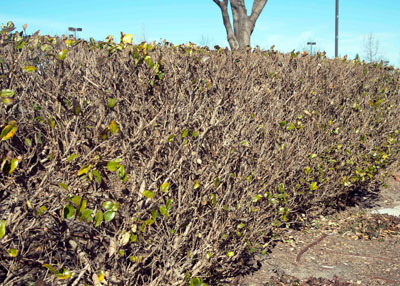Cold Damage Notes

Photo: Parking lots in a commercial planting in Allen are lined with frozen waxleaf ligustrums. It’s unlikely that they will rebound from the damage.
My wife and I went out for a quick dinner in Allen (north of Dallas) the other evening. We parked in a lot we’ve been in dozens of times, but somehow things looked very different in the twilight. “Maybe it’s the lighting, but I can’t tell what those shrubs are that are lining these lots. I can’t imagine they’ve trimmed them that severely and removed every last leaf in the process,” I said.
The shrubs were waxleaf ligustrums. Emphasis on “were.” I’m wondering if any of those plantings will survive and start growing again. The few leaves that still hang are pockmarked and browning. That’s a sight I saw after the prolonged cold of 1983-84 and again after the extreme cold of December 23, 1989, when it dropped below zero on our rural McKinney thermometer. For the ensuing years people in North Texas were reluctant to plant waxleaf ligustrums again, fearing that could happen when cold weather returned. But then several warm winters gave encouragement, and many were planted.

Photo: You can see the damage the freeze did to the ligustrum leaves. As significant as the loss of foliage has been, I don’t think these plants will recover.
It looks like this was a glancing blow to waxleaf ligustrums. Plantings just across the parking lot (that had not been kept so tightly cropped) still look good and will probably be fine. But the plants that had been weakened by years of close shearing appear to be gone. That’s going to involve a massive replanting. (That’s hot on the heels of the hundreds of Knockout roses this center manager is having to replace due to rose rosette virus.)
So it is with many oleanders in DFW and even much farther southward. And pittosporums and gardenias. Bottlebrush, sago palms and some types of citrus in Central and South Texas were toasted. I haven’t seen your yard, but you probably have your own list.
Don’t be surprised if you see damage to one set of plants, when another planting of the same type of plant is untouched. As mentioned, it could be due to weakening of close pruning. It could be proximity to pavement, exposure to north winds, moisture levels at the time the cold hit – there are many variables.
The important take-away from all of this is that we need to go back with types of plants that are reliably winter-hardy for our area. That’s especially critical when several (or many) of a given species are going to be planted. Save your risky plants for smaller numbers in protected locations. Let a Texas Certified Nursery Professional advise you on the best plants for your specific needs.
